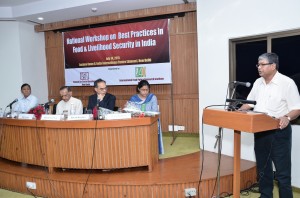Cross-posted from the FSP India website written by Jaspreet Aulakh
A recent conference organized jointly by the Council for Social Development (CSD) and the International Food Policy Research Institute (IFPRI) explored research gaps on food and livelihood security and existing models that could be used for successful change.
To ignore current food security issues facing India can be likened to a doctor refusing to perform surgery because the future will offer better methods, said Muchkund Dubey of the CSD.
The conference was held 14 July at the India International Centre in New Delhi, and brought together members of government and the private sector to discuss models and processes that are scalable as well as their applicability in particular situations. The discussion also centered on topics associated with existing practices that demand more research.
Four technical sessions covered best practices related to the Public Distribution System (PDS), the Mahatma Gandhi National Rural Employment Guarantee Scheme (MGNREGA), food security and self-help groups, and civil society organisations. The conference closed with a panel discussion on “Learning Lessons for Up-Scaling Best Practices.”
There was unanimous consensus on the definitions of best practices, food security, and livelihood security: best practices (BPs) in agriculture were defined as norms which help rural agricultural systems to self-sustain, ensuring food as well as livelihood security; food security should incorporate food availability, food access, food safety, and food nutrition; and livelihood security means income generation for the rural and urban population.
Several points were highlighted during the course of the conference. First, each state in India varies greatly in terms of socioeconomic makeup and politics, which makes the cross-implementation and upscaling of best practices based on case studies alone difficult. Second, the government and political system can make a huge difference in creating success stories. Third, the use of information technology in management of any agricultural system is necessary for creating a success story. Capacity building and diversification within agricultural systems is also necessary to protect them from shocks.
During the final discussion, Former Secretary to the Government of India Alok Sinha noted that Indian agriculture has reached a plateau; half of the population is engaged in agriculture, but it contributes to only 2-3 percent of the country’s GDP. Small projects scattered over India cannot represent the country as a whole, he said, and PDS needs to become a transparent public system where the beneficiaries know their rights. Since Minimum Support Price (MSP) and PDS are closely interlinked, the cash transfer policy can adversely affect MSP and PDS and should therefore be tested before implementation. Digital tracking is also important for procurement to end in PDS.
Agriculture impacts a large percentage of the Indian population—47 percent of the population was employed in agriculture and related activity in 2012, according to the World Bank-- and civil society has an important role serving the rural poor.
For additional coverage and lessons-learned from the conference, check out our blogs on:
Civil Society Organizations in India-- how they make a difference
Growing together, gaining together-- case studies of self-help groups
